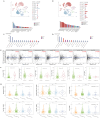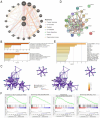Comprehensive analysis of prognostic value and immune infiltration of Regulator of Chromosome Condensation 2 in lung adenocarcinoma
- PMID: 38434981
- PMCID: PMC10905397
- DOI: 10.7150/jca.91367
Comprehensive analysis of prognostic value and immune infiltration of Regulator of Chromosome Condensation 2 in lung adenocarcinoma
Abstract
Background: Lung adenocarcinoma (LUAD) incidence and mortality take the leading place of most malignancies. Previous studies have revealed the regulator of chromosome condensation 1 (RCC1) family members played an essential role during tumorigenesis. However, its biological functions in LUAD still need further investigation. Methods: Several databases were applied to explore potential effects of RCC1 family members on LUAD, such as Oncomine, GEPIA, and cBioPortal. Real-time PCR and immunohistochemistry were used to verify the expression of RCC2 in stage I LUAD. H1975 and A549 were selected to explore the biological function of RCC2 in cellular malignant phenotype. Results: The expressions of RCC1 and RCC2 showed marked differences in malignant tissue compared to lung tissue. The higher the expression levels of RCC1 or RCC2 in LUAD patients, the shorter their overall survival (OS). In normal lung tissues, RCC1 expression was highly enriched in alveolar cells and endothelial cells. Compare with RCC1, RCC2 expression in normal lung tissue was significantly enriched in macrophages, B cells and granulocytes. Additionally, RCC2 expression level was correlated with multiple immune cell infiltration in LUAD. Moreover, the mutation or different sCNA status of RCC2 exerted influence on multiple immune cell infiltration distribution. We found that the upregulation of RCC1 and RCC2 were obviously related to TP53 mutation. GSEA analysis revealed that RCC2 was involved in the process of DNA replication, nucleotide excision repair and cell cycle, which might affect tumor progression through P53 signaling pathway. We further elucidated that downregulation of RCC2 could dramatically repress the migration and invasion of LUAD cells. Conclusions: The study demonstrated that RCC1 and RCC2 expression were markedly increased in early-stage of LUAD. Patients with high expression of RCC1 or RCC2 had a worse prognosis. Based on our analysis, RCC1 and RCC2 might exert influence on LUAD process through DNA replication, nucleotide excision repair and cell cycle, as well as cells migration and invasion. Different from RCC1, RCC2 also involved in immune infiltration. These analyses provided a novel insight into the identification of diagnostic biomarker.
Keywords: RCC1; RCC2; TP53; immune infiltration; lung adenocarcinoma.
© The author(s).
Conflict of interest statement
Competing Interests: The authors have declared that no competing interest exists.
Figures








Similar articles
-
Overexpression of RCC2 Enhances Cell Motility and Promotes Tumor Metastasis in Lung Adenocarcinoma by Inducing Epithelial-Mesenchymal Transition.Clin Cancer Res. 2017 Sep 15;23(18):5598-5610. doi: 10.1158/1078-0432.CCR-16-2909. Epub 2017 Jun 12. Clin Cancer Res. 2017. PMID: 28606921
-
A human pan-cancer system analysis of regulator of chromatin condensation 2.Heliyon. 2023 Feb 10;9(2):e13599. doi: 10.1016/j.heliyon.2023.e13599. eCollection 2023 Feb. Heliyon. 2023. PMID: 36865448 Free PMC article.
-
Multiomic Characterization of RCC1 and RCC2 Expression and Their Association With Molecular Alterations, Immune Phenotypes, and Cancer Outcomes.JCO Oncol Adv. 2025 May 1;2(1):00022. doi: 10.1200/OA-24-00033. eCollection 2025. JCO Oncol Adv. 2025. PMID: 40330141 Free PMC article.
-
SNCA correlates with immune infiltration and serves as a prognostic biomarker in lung adenocarcinoma.BMC Cancer. 2022 Apr 14;22(1):406. doi: 10.1186/s12885-022-09289-7. BMC Cancer. 2022. PMID: 35421944 Free PMC article.
-
Regulator of Chromosome Condensation 2 Modulates Cell Cycle Progression, Tumorigenesis, and Therapeutic Resistance.Front Mol Biosci. 2021 Jan 13;7:620973. doi: 10.3389/fmolb.2020.620973. eCollection 2020. Front Mol Biosci. 2021. PMID: 33521058 Free PMC article. Review.
Cited by
-
Multi-omic profiling of breast tumor microenvironment uncovers a role of mitochondrial calcium gatekeepers.J Cancer. 2024 May 13;15(12):3663-3674. doi: 10.7150/jca.95979. eCollection 2024. J Cancer. 2024. PMID: 38911376 Free PMC article.
-
Decoding oncogenic secrets of regulator of chromosome condensation 1: A breakthrough mechanistic evidence from breast and lung cancer models.PLoS One. 2025 Mar 31;20(3):e0319748. doi: 10.1371/journal.pone.0319748. eCollection 2025. PLoS One. 2025. PMID: 40163507 Free PMC article.
References
-
- Siegel Rl, Miller Kd, Jemal A. Cancer statistics, 2019. CA: a cancer journal for clinicians. 2019;69:7–34. - PubMed
LinkOut - more resources
Full Text Sources
Research Materials
Miscellaneous

